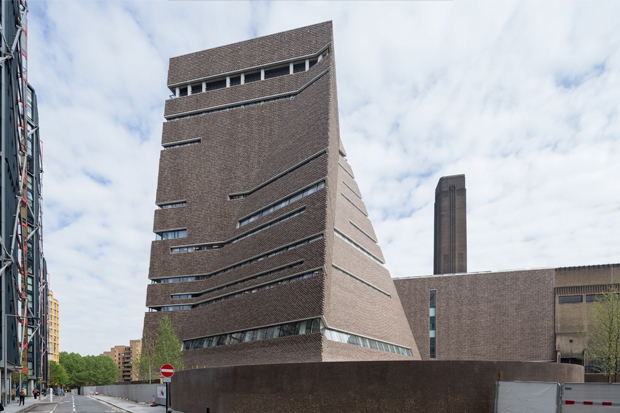Tate Modern, badly overcrowded, has built itself a £260 million extension to spread everyone about the place more. This means that there are more galleries and other big rooms for various modish activities — 60 per cent more space, they say. It opens on 17 June with a total rehang throughout. But having been shown round the place, I’ve become transfixed by the lifts.
When it opened in 2000 they never expected nearly five million visitors a year — which is well down on its 2014 Matisse-driven peak of nearly six million, but still twice as many as it was designed for. So when they called back Swiss architects Herzog and de Meuron to extend the gallery that brought them fame, moving people around better was high on their to-do list.
When you enter the perforated-brick ziggurat of the new ten-storey extension, therefore, what you find inside is an impressively huge bank of lifts, worthy of one of the mega-lobbies at Canary Wharf. You also find one heck of a fine sweeping staircase in smooth moulded concrete, spawn of a brutalist Busby Berkeley. Finally on the people-distribution front, there is a new south entrance where there was none before. Sir Giles Gilbert Scott’s 1950s Bankside power station, which Tate took over, pointedly turned its back on poor old Southwark. Now you’ll be able to walk right through the place, from one side to the other if you like, tempted by a big ground-floor bar on the way.
The ziggurat rises high above the roof of the old power station, topped by an open public observation deck that does the business, giving you a fine new view across to the flank of St Paul’s cathedral, or south London if you prefer. You’re some 200 feet up, which is optimum for such a belvedere. Much better than the Shard, say, where you’re so high that you are essentially gazing down at a relief map. As at the Pompidou Centre in Paris, a lot of visitors will just head straight for the viewpoint and ignore the art inside. So it’s a pressure-relief valve. A new restaurant and a much bigger members’ room are high up here, too.
It’s a strange object, this ziggurat, with its curious, knobbly, loose-weave brick overcoat, wrapping somewhat awkwardly round the building’s sharp creases. Brick just doesn’t want to be used like a net in this way and it’s distinctly perverse, not to mention very fiddly and expensive, to do so. Inside it’s all exposed concrete, very different from the old power station, which is steel beneath its skin. This concrete is fully fetishised — you find it used in the ceilings as well as the walls, even moulded into long sexy benches where you can sit to wait for your lift.
Strip windows — vertical and horizontal — slice through the walls which, being perforated brick, you can see through anyway in many places. So it’s an industrial aesthetic, generated by the old circular concrete oil-storage tanks — now basement galleries for live performance and film. From these the ziggurat rises in a pleasing internal chaos of angled columns if you like that kind of thing, and I surely do. Shame, though, about all the nasty little opening windows everywhere with their clumsy metal frames. It’s a low-energy building with a lot of natural ventilation rather than power-hungry air-conditioning, and it seems these clunky windows are the price of eco-virtue.
The bulk of the new spaces are in the old transformer and switchgear hall on the power station’s south side. It’s still in use, supplying the City, but the kit is now much smaller. Half of it was cleared for the Tate to rebuild and move into.
Consider the biggest of the new gallery floors, on level 2. It’s 210 feet long by 50 feet wide, and tall with it. That’s sports-hall size, divided in two for the opening hang. In all there are three levels of new galleries, corresponding to the existing three on the north side of the building. They are linked by a broad pedestrian bridge across the turbine hall at high level, just beneath its roof.
The new spaces are designed to feel much like the existing galleries — the same rough-sawn oak floors, for instance. The concrete ziggurat interior doesn’t quite come off but these new galleries look promising. Much more of the collection will be on display. And the lifts are lovely.






Comments